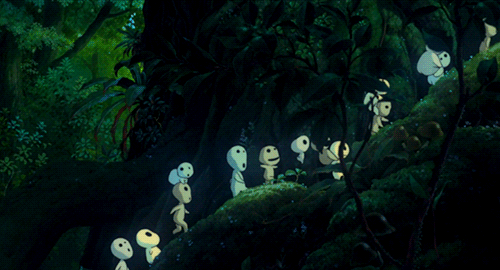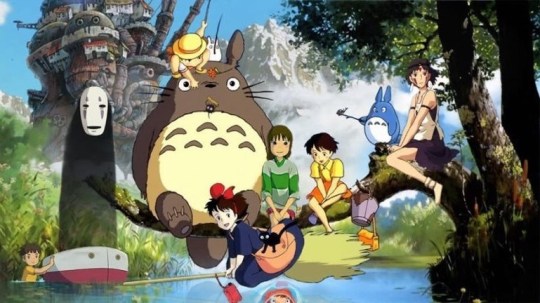#but i do think focusing on them as pure everyday objects instead of holy ones is just cutting out a chunk of what's going on
Text
I think ignoring religious themes when speaking about possession of the Silmarils in favour of getting bogged down in modern property law is missing the point
#silmarillion#silmarils#i think i get why people do it#at least some times#but i do think focusing on them as pure everyday objects instead of holy ones is just cutting out a chunk of what's going on
133 notes
·
View notes
Text
As the Spirit Moves You: How Studio Ghibli Films Leave Room for A Range of Religious Interpretations

Today’s guest post is by Kaitlyn Ugoretz, a PhD student in the Department of East Asian Languages and Cultural Studies at the University of California, Santa Barbara whose research focuses on the globalization of Shinto through popular and digital media and the growth of online Shinto communities.
Since childhood, my life has been suffused with an appreciation for both anime and religion. Saturday mornings were dedicated to the weekly ritual of watching cartoons with my father (Pokemon, Yu-Gi-Oh!, Sailor Moon, Mobile Suit Gundam Wing—if it was on Toonami or WB Kids, we watched it!), and Sunday mornings were spent listening to him preach the gospel as the minister of our small Presbyterian church.
As a child, I never really thought about how anime and religion might intersect, but all that changed after I watched Miyazaki Hayao’s Spirited Away. Something about the heroines, spirits, and grand narratives about relationships between humans and the environment spoke to me and inspired a fascination that continues to shape my adult life. And thanks to social media and blogs like Beneath the Tangles, I know that I’m far from alone in feeling that there is something deeper—something that goes beyond what we might think of as “mere” entertainment—to be found in many anime. Today, I study the variety of religious/spiritual responses to anime as a scholar of Japanese religion, popular culture, and digital media.
Ghibli—Global Giant
Shinkai Makoto’s 2017 blockbuster animated film Your Name has given Spirited Away a run for its money in the box office, but Miyazaki Hayao’s 2001 masterpiece reclaimed its status this past June as the highest grossing anime film in the world after its long-awaited release in China. Studio Ghibli has produced an impressive 10 out of the world’s top 50 highest grossing animated films, including beloved favorites My Neighbor Totoro, Princess Mononoke, and Ponyo.

Box office earnings are not necessarily an indicator of the spiritual depth of Studio Ghibli’s films, but they do demonstrate their enduring global appeal. Scholars of Japanese religion and popular culture, most notably Jolyon Baraka Thomas and Katharine Buljan and Carole M. Cusack, have shown that Miyazaki Hayao and Isao Takahata’s anime films resonate with audiences from a wide range of religious and cultural backgrounds and even inspire religious responses.
What is it about Ghibli films that continues to capture the hearts of people from all walks of life and allows for such a diversity of religious interpretations? Considering how Miyazaki represents his filmic intentions, in addition to how scholars and different fan audiences have interpreted the meaning of Studio Ghibli films, I find that it is the mixture of familiar and foreign religious elements that inspire us to reexamine our own beliefs and seek out those messages that resonate with us.
Miyazaki’s Mixed Messages
What Miyazaki intended to communicate to his audience through his films? After all, he is well-known for addressing moral and social concerns, including adolescence, good and evil, humanity’s relationship with nature and technology, modern anxieties, and nostalgia for the past. Given his tendency to populate his fictional worlds with spirits or gods (typically referred to as kami in Japanese) and other supernatural creatures who are closely related with nature, like the river spirit in Spirited Away and the Forest Spirit in Princess Mononoke, Miyazaki is often asked whether his films are meant to foster Shinto beliefs.

Cleansed river spirit

Shishigami-sama, the Great Forest Spirit
Shinto is a difficult tradition to define, as it has meant different things to different people throughout history. Some classify Shinto as a religion with clear beliefs and practices, while others characterize it as an essential part of everyday life in Japan which can only be understood experientially. In any case, most can agree that—at its core—Shinto is a ritual tradition which centers on the worship of kami, divine entities that inhabit extra-ordinary natural phenomena and man-made objects and whose favor grants benefits to one’s life in this world.
While this definition may seem to suit Miyazaki’s films well, the creator himself explicitly rejects Shinto as the source of his inspiration. Miyazaki grew up in the midst of WWII and his understanding of Shinto is informed by the legacy of what scholars call “State Shinto,” the modern Japanese government’s takeover of Shinto shrine affairs in order to promote imperialist and nationalistic ideologies. The filmmaker has given ambiguous answers to the question of whether his films are influenced by religion. In one interview, Miyazaki elaborated:
Dogma inevitably will find corruption, and I’ve certainly never made religion a basis for my films. My own religion, if you can call it that, has no practice, no Bible, no saints, only a desire to keep certain places and my own self as pure and holy as possible. That kind of spirituality is very important to me. Obviously it’s an essential value that cannot help but manifest in my films.
Through his consistently vague characterization of his personal brand of spirituality, Miyazaki—like any masterful storyteller—leaves room for his audience to draw upon the rich imagery, relatable characters, and familiar themes to create their own meaningful interpretations.
Scholarly Interpretations
Scholars of religion and media have interpreted Miyazaki’s works from a number of theological perspectives. Some argue that the kami characters and environmental ethics which Miyazaki employs are clearly drawn from Shinto, despite his claims to the contrary. Others have offered Christian interpretations of Miyazaki’s films. For example, Prince Ashitaka (Princess Mononoke) and Princess Nausicaä (Nausicaä of the Valley of the Wind) have been analyzed as messianic mediators between the profane and sinful realm of humanity and the sacred realm of Nature/Creation, as well as messengers of the gospel, promoting love and nonviolence.

Ashitaka goes into exile to restore harmony

Nausicaä is healed by the Ohm
Fan Interpretations
Scholars aren’t the only ones interested in the spiritual underpinnings of Ghibli films—fans around the world gather on- and offline to discuss their personal interpretations. These conversations are more than intellectual exercises; Thomas and Buljan and Cusack have shown that popular media like anime can inspire religious responses in audience members as well as entertain. That is, Ghibli films may influence viewers’ worldview and behavior, even if these viewers do not consider themselves to be religious. Thomas’s survey of Japanese fans shows that this influence may take many forms, such as a “belief in an immanent spiritual bond existing among all living things,” a pilgrimage to a special site like Yakushima forest (supposedly a source of inspiration for the sacred forest in Princess Mononoke), or a reenactment of the acorn-growing ritual portrayed in My Neighbor Totoro.

Erika Ogihara-Schuck examines how Miyazaki’s films have been translated into English and German in such a way as to secularize the spiritually-charged elements, referring to kami characters as “spirits” rather than “gods” and their powers as “magical” instead of “sacred” or “divine.” In some cases, this translation project has succeeded; some fans view Miyazaki’s films as ‘simply entertaining,’ while others read them as uncomfortably morally ambiguous, superstitious, or explicitly opposed to Christian theology. Still others in the Christian blogosphere—including contributors on sites such as Beneath the Tangles and Christ X Pop Culture—have found plenty of food for thought in Studio Ghibli films, prompting discussions of how anime narratives might productively challenge and affirm their core values as brothers and sisters in Christ.
Some audiences, as I have discovered in my own research, draw upon Studio Ghibli films as a source of Shinto spiritual instruction. In my study of the growth of predominantly non-Japanese online Shinto communities (OSCs) on social media, I find that anime plays an important role in the fostering of interest in Japanese religions, as well as participation in OSCs.
In interviews, surveys, and posts, several of the leading, active members of OSCs have noted that their early exposure to Ghibli films are what inspired their further study and adoption of Shinto. In community discussions, members share their interpretations of religious elements in anime. These conversations often focus on the relationship between humanity, kami, and nature and affirm the importance of moral character and gratitude. In similar fashion to other online religious communities, OSC members will comment on posts and keep the discussion going, negotiating interpretations, sharing links to blog posts and video clips which they find informative, and posing further questions.

In response to new members’ requests for more information about Shinto, each OSC has created its own list of recommended resources, which often include anime films and series in addition to books and blogs. As such, Studio Ghibli films like Spirited Away and Princess Mononoke have become, in effect, ‘required reading’ for OSC members. In this way, Ghibli films function as an important introduction to Japanese spirituality—particularly Shinto—for international audiences and a resource for the construction of personal and community beliefs.
Language Games
How can Studio Ghibli films spark so many different religious responses and interpretations—Christian, Shinto, and otherwise? The answer lies with two key concepts: Jolyon Baraka Thomas’s theory of “playful religion” and Leonard Primiano’s theory of “vernacular religion.”
Thomas argues that the distinction we make between religion and entertainment is artificial; entertainers can playfully use religious symbols to create an engaging story, and viewers can derive spiritual meaning from popular media, regardless of whether the creator intended for them to do so.
“Vernacular religion” refers to religion as it is lived—not what religious authorities say religion ‘should be,’ but how religious concepts are translated into a particular culture and actually practiced by people.
One way anime creators like Miyazaki manage to both entertain and inspire their audiences is to ‘play’ with the ‘languages’ of religion. These language games are a lot like playing Mad Libs. The storyteller chooses from among a variety of popular religious images and themes from different traditions—our collective religious vocabulary bank—and removes them from their original context. These religious elements are then recombined within a familiar narrative framework to create new images and stories that are compelling because they are both familiar and foreign to us. It is left up to each of us as audience members to make sense of these disassociated religious elements by translating them back into our own vernacular of faith.
Understanding this process of translation we all participate in as Studio Ghibli fans is important for two reasons. First, it reminds us that the meaning or significance of an anime is not defined by any one person’s vision, even that of its creator. No one has the ‘right’ answer. Our personal interpretations and those of others are just as meaningful, because they are grounded in our beliefs and thus have the power to affect the way we look at the world and live our lives. Second, the fact that the same images and themes can resonate with people of different faiths and backgrounds speaks to values we have in common, as well as a common desire to be spiritually engaged, as well as entertained, by the media we consume. Ultimately, the genius of Studio Ghibli films lies in their rich assemblage of religious symbols and grand narratives, which audience members are—if they are so inclined—free to interpret in a way that affirms their beliefs and feeds their soul.

Kaitlyn Ugoretz is a PK (Pastor’s Kid), anime fan, and PhD student in the Department of East Asian Languages and Cultural Studies at the University of California, Santa Barbara. Her research focuses on the globalization of Shinto through popular and digital media and the growth of online Shinto communities. Kaitlyn runs Digital Shinto, a site where anyone can learn about and participate in her ethnographic study of Shinto’s development outside of Japan.
—
Recommended Reading:
Buljan, Katherine and Carole M. Cusack. Anime, Religion, and Spirituality: Profane and Sacred Worlds in Contemporary Japan. Sheffield: Equinox Publishing Ltd., 2015.
Ogihara-Schuck, Erika. Miyazaki’s Animism Abroad: The Reception of Japanese Religious Themes in German and American Audiences. Jefferson, NC: McFarland & Company, Inc., 2014.
Park, Jin Kyu. “‘Creating My Own Cultural and Spiritual Bubble’: Case of Cultural Consumption By Spiritual Seeker Anime Fans.” Culture and Religion 6.3 (2005): 393-413.
Thomas, Jolyon Baraka. Drawing on Tradition: Manga, Anime, and Religion in Contemporary Japan. Honolulu, HI: University of Hawai’i Press, 2012.
86 notes
·
View notes